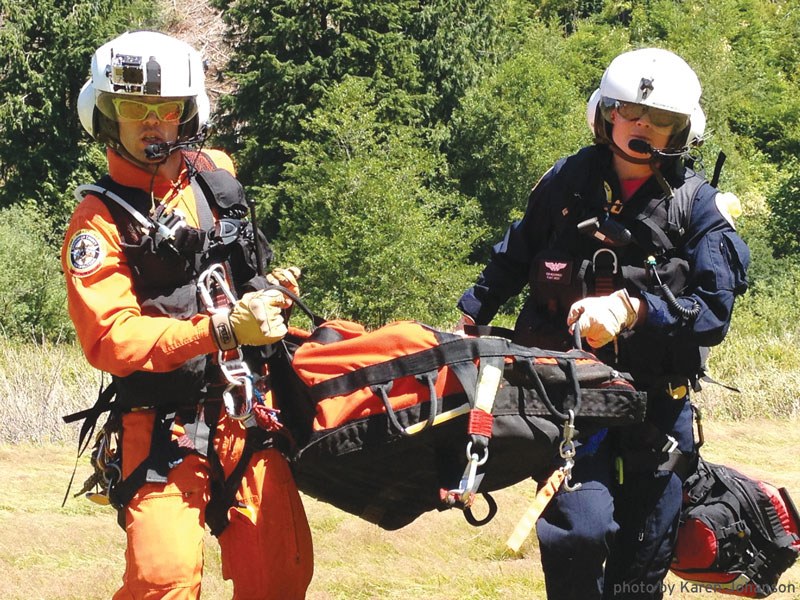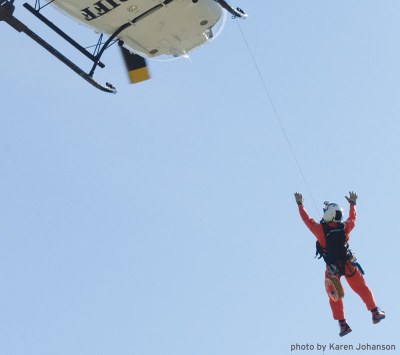
The level of outdoor community support in the Pacific Northwest is truly unmatched. As a transplant myself, I know it can be difficult to make connections in a new place. Not so much when you go outside. You can roll up to any trailhead, crag, or mountainside and form friendships to last a lifetime. That’s why it’s only fitting that I should find myself here, working at The Mountaineers, through a lucky connection with a fellow outdoor enthusiast: Miles McDonough.
A Mountaineer and volunteer rescuer, Miles is also one of my good friends. We met in early 2012 as he was recovering from a pretty catastrophic climbing accident. Throughout his whole ordeal he stayed active, maintained a great attitude, and continued volunteering. More importantly for me, Miles stayed connected with the outdoor community. He saw The Mountaineers’ job description for a Membership & Marketing Manager, shared it on Facebook, and now,
here I am — working with a fantastic group of outdoor enthusiasts. I will forever owe him a debt of gratitude (along with many beers).
Growing up, Miles always felt a strong desire to get outside. He possessed a propensity for figuring things out on his own and getting after it.
His stoke was high, but he eventually realized he’d need better skills to increase his margin of safety in the backcountry. He joined the Mountaineers in 2008.
Miles enrolled in The Mountaineers’ 80-hour Wilderness First Responder course taught by Remote Medical International (RMI). He explains, “The vast majority of us rarely encounter wilderness emergencies, so it can be difficult to convince ourselves to invest the time and effort into learning and maintaining these skills.” However, the subject resonated with him so much that six months later, he enrolled in RMI's Wilderness EMT course.
In 2010, Miles began volunteering with our First Aid program. By then, he had graduated Basic and Intermediate Climbing, taken sailing, avalanche awareness, cross-country and backcountry skiing. But his passion truly lies in Wilderness Medicine.
Miles initially turned to volunteering with The Mountaineers as a way to maintain his own knowledge base and help pass his skills on to others. He helped create the Alpine First Aid Committee in order to revamp the Mountaineers Oriented First Aid (MOFA) program. He worked with fellow volunteers to standardize the curriculum, bring in professional instructors, and offer more first aid courses throughout the year to meet our growing demand. Most importantly, the subcommittee created weeknight scenario sessions to provide our members with more opportunities to maintain their wilderness first aid skills in a relaxed, friendly environment.
In addition to teaching the skills he needed to get outside safely and responsibly, Miles also credits The Mountaineers with helping him meet his best friends. Through his courses, he forged a set of relationships that still dominate his life. He climbs, skis, lives, travels, and works on the rescue teams with the same set of individuals that he met through The Mountaineers. It’s through these same friends that I met Miles.
A Rescuer
In addition to his volunteer work with The Mountaineers, Miles joined the Everett Mountain Rescue Unit (EMRU) in 2009. EMRU is a volunteer organization of climbers providing technical rescue services in rugged mountain terrain. Many of the volunteers for EMRU have come up through training with The Mountaineers. In fact, mountain rescue organizations as they exist on a nationwide scale are founded after early rescues conducted by The Mountaineers.
Miles became even more involved in mountain rescues when he applied for a position as a Rescue Technician/EMT with the Snohomish County Helicopter Rescue Team (HRT) in late 2010. HRT works closely with EMRU to provide additional support for rescues in rugged terrain requiring a helicopter for extraction.
When I asked why rescue work appealed so much to him, Miles had the perfect answer: “I’m interested in wilderness medicine, love every moment I spend in the backcountry regardless of the weather or conditions, and get satisfaction from using my mountaineering skills to help people in need.”
Miles and his fellow volunteers are exactly the type of people you want coming to your aid in the wilderness, a reality Miles would soon experience for himself.
A Survivor
On September 7, 2011, Miles set off with his friend Matt to climb the West Ridge of Mt. Stuart in a single day. There was not a cloud in the sky. The climbing was fantastic, efficient, and the route finding straightforward. All was going according to plan until Miles pulled off a loose block below the summit at 9,400’. Miles fell, tumbling for 65 feet, and suffered substantial injuries. It was noon.
Matt, unable to descend to Miles due to the technical terrain and a severely damaged rope, was able to slide supplies down to Miles, who had lost his own pack in the fall. Without a cell phone or personal locator beacon, Matt then descended the technical route without a rope, found a hiking party, borrowed their cell phone, and ran up Long’s Pass to place a call to 911. Approximately five hours had passed since the accident.
For Miles, the most difficult portion of the whole ordeal was waiting. “I knew my climbing partner was soloing down the West Ridge and I was sick with worry for what might happen to him,” Miles said. Then, miraculously, a helicopter doing reconnaissance for the rescue crested the ridge around 8pm, just as sun was setting. For the first time in eight hours Miles felt temporary relief. This meant Matt had made it down safely and help was on the way.
But Miles still had to make it through the night. Cold, alone, bleeding and in incredible pain, Miles spent an agonizing night solo on the mountain with nothing but the clothes on his back and an emergency blanket, which was eventually ripped to shreds by the wind. But worst of all, he continued to worry about the rescuers – most likely some of his best friends. Based on his own volunteer experience, he knew the difficult rescue tasks that lay ahead.
Meanwhile, a complex and technical rescue ensued, eventually involving both EMRU and HRT, in addition to Whidbey Naval Air Station and Chelan Mountain Rescue. While a mountain rescue team from EMRU climbed the Cascadian Couloir through the night, the helicopter team was developing a plan of attack. The EMRU team arrived just in time to rappel to Miles and assist HRT with a hoist extraction, whisking Miles away in a specialized harness. Miles finally arrived at the Central Washington Hospital in Wenatchee almost 22 hours after the accident.
His recovery was long and involved. “I had shattered my scapula, fractured five ribs, collapsed a lung, suffered a serious concussion, and sustained an eight-inch avulsion along my shin in addition to a number of other lacerations and contusions,“ he said. “While all of these injuries healed within the first several months, they only revealed the real damage that had been done. The impact of the fall had ripped a portion of my brachial plexus, the nerve bundle that innervates the shoulder. Despite the healed bones, I could not move my right arm at all.” It was around this time that I first met Miles, his right arm hanging at his side, his right shoulder appearing bony and sunken due to muscle atrophy.
After extensive research into a specialized surgical technique, Miles flew to Baylor University to undergo a nerve transplant six months after the accident. The goal was to replace the dead nerve in his shoulder with a live nerve from his calf. The hope was that the transplanted nerve would grow back, allowing his brain to once again ‘talk’ to his arm to restore movement. After nine months of intensive physical therapy, Miles regained nearly full function of his arm.
A Proponent for Paying it Forward
Miles considers himself “incredibly fortunate.” He is truly lucky to be here, and frankly, we’re lucky to have him. Not only did he endure this harrowing ordeal, but he has returned to active duty as a Rescue Technician/EMT with the Helicopter Team and is currently serving as the membership chair of EMRU.
“I was passionate about rescue work previously, but now, having been the rescued, I understand intimately what is at stake. More and more of my time is poured into these two organizations as I look for ways to pay things forward.”
But then, HRT lost its federal funding grant in early 2013. All of a sudden this non-profit, volunteer run team was at risk of disappearing. You see, HRT and EMRU do not charge for any of the rescues or the medical care they provide. And it’s not just technical climbers who benefit from the services. Remember the recent I-5 bridge collapse? HRT was there, helping the other helicopters look for cars trapped in the river. EMRU made headlines a few years ago for assisting with the rescue of a boy who had fallen into the water and had been trapped on a ledge just above 270’ Wallace Falls. They aid anyone from the casual outdoorsman to the serious weekend warrior. Combined, HRT and EMRU conduct an average of 80 missions per year in Snohomish, Chelan, King, Skagit, Whatcom, and Pierce Counties.
Support the Last Resort
Miles has made it his personal goal to find a sustainable source of funding so HRT/EMRU can continue saving lives for decades to come. He, along with a team of passionate volunteers representing both HRT and EMRU, built a website (www.SupportTheLastResort.com) and a Facebook page to raise awareness of the funding dissolution. They designed and started selling t-shirts, hosted public outreach events, and sought donors and sponsors to raise money. His ultimate goal is to find sustainable funding, even if it means spending more time on the phone with potential sponsors and less time out in the field doing what he loves. Without efforts such as these, HRT would cease to exist at the end of 2014.
Every life saved belongs to a member of our community: a wife, a husband, a son, a daughter… a future rescuer. We can all feel a little safer knowing HRT is out there working hard – just in case – so we can continue to enjoy the mountain adventures we love.
Want to show your support?
Support at any level by visiting www.SupportTheLastResort.com to make a donation.
This article originally appeared in our March/April 2014 issue of Mountaineer magazine. To view the article in magazine form and read more stories from our bi-monthly publication, click here.
 Kristina Ciari Tursi
Kristina Ciari Tursi
